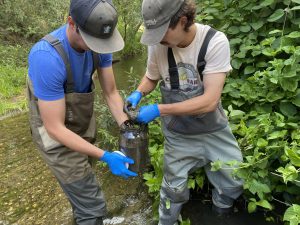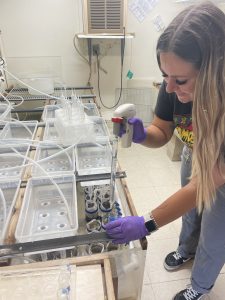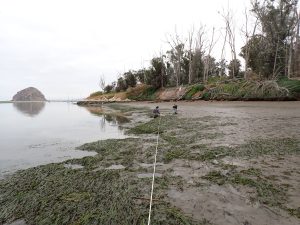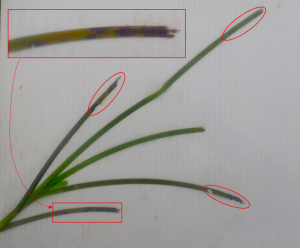The Estuary Program conducts routine monitoring to help track the health of the estuary and the creeks that drain into it. In June, our team piloted a new toxicity monitoring effort and continued our seasonal eelgrass health assessment. These efforts guide our conservation and restoration efforts and inform management.
Toxic Contamination
Toxic pollutants pose a threat to ecosystems by altering water and soil chemistry. These changes can affect the behavior and reproduction patterns of aquatic species and, in severe cases, may even cause mortality. Toxic contaminants can accumulate in sediment and be released slowly over time, thus acting as a long-term pollution source to our waterways. Potential sources of toxic contamination include storm runoff, untreated wastewater, and hazardous materials spills.
To better understand the extent of toxic contamination in the Morro Bay watershed, the Estuary Program is undertaking a new monitoring effort where staff collect water and sediment samples and send them off to a laboratory for toxicity testing. The resulting data helps us identify polluted areas and better understand the direct impacts to aquatic life from the water and sediment present in our creeks.

Testing for Toxicity
In June, staff collected water and sediment samples from two sites in the Chorro Creek subwatershed and one site in the Los Osos Creek subwatershed. After collection, the samples were hand-delivered to personnel from the UC Davis Granite Canyon Lab.
To assess toxicity, the lab uses indicator species like algae and insects that are known to be sensitive to pollution. The lab puts these organisms in the water and sediment collected from our creeks. The lab then tracks the survival and growth of the organisms. If the organisms can survive and thrive over the study period, there is likely no toxic material present in the sample.

Monitoring Eelgrass Health
Eelgrass (Zostera marina) is a flowering seagrass that grows in the Morro Bay estuary. Eelgrass is important for bay health, as it serves as a source of food and habitat for a diverse range of species. It also helps to improve water quality by stabilizing sediment and producing oxygen. To read more about the status of eelgrass in the estuary, please click here.

The Estuary Program monitors eelgrass health in several different ways. During the spring, our staff take an in-depth look at the condition of our eelgrass beds. We collect data like the length of the eelgrass blades, the presence of algae covering the blades, and the appearance of dark patches that could indicate diseased tissue.
The results of our monitoring have shown that there is diseased or decaying tissue present in eelgrass beds throughout the estuary. The amount of decay varies by location. This disease takes advantage of stressed or weakened blades and decomposes the surrounding tissue. This decomposition creates characteristic dark spots along the otherwise green and healthy-looking plant. Despite the presence of diseased tissue, the survival of the eelgrass plant is not necessarily impaired as long as adequate green blades are left to support photosynthesis.

A large component of our spring eelgrass monitoring involves analyzing photos of eelgrass blades that are taken in the field. If you’re interested in how the photo processing works, check out last year’s blog post discussing this project.
Help us protect and restore the Morro Bay estuary!
- Donate to the Estuary Program today and support our work in the field, the lab, and beyond.
The Estuary Program is a 501(c)3 nonprofit. We depend on funding from grants and generous donors to continue our work. - Support us by purchasing estuary-themed gear from ESTERO. This locally owned and operated company donates 20% of proceeds from its Estuary clothing line and 100% of Estuary decal proceeds to the Estuary Program. Thank you, ESTERO!
- Purchase items from the Estuary Program’s store on Zazzle. Zazzle prints and ships your items, and the Estuary Program receives 10% of the proceeds. Choose from mugs, hats, t-shirts, and even fanny packs (they’re back!) with our fun Estuary Octopus design, our classic Estuary Program logo, or our Mutts for the Bay logo.
- We want to hear from you! Please take a few minutes to fill out this short survey about what type of events you’d like to see from the Estuary Program. We appreciate your input!
Thank you for helping our beautiful, bountiful, biodiverse bay!